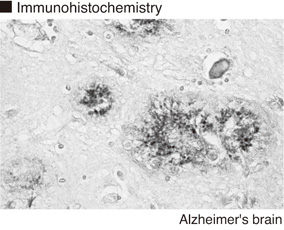Anti-Apolipoprotein E4 (Human) mAb
| Code | Size | Price |
|---|
| MBL-M067-3 | 100 ug | £331.00 |
Quantity:
Prices exclude any Taxes / VAT
Overview
Host Type: Mouse
Antibody Isotype: IgG1
Antibody Clonality: Monoclonal
Antibody Clone: 1F9
Regulatory Status: RUO
Target Species: Human
Applications:
- Immunohistochemistry (IHC)
- Immunoprecipitation (IP)
- Western Blot (WB)
Shipping:
4°C
Storage:
4°C
Images
Documents
Further Information
Applications:
WB - 1 ug/mL (chemiluminescence detection system) IP - 5 ug/2 uL of human serum IHC - 10 ug/mL
Background:
Apolipoprotein E (ApoE), a 35 kDa plasma protein containing sialic acid, plays a role in triglyceride, cholesterol transport and metabolism, and known to be synthesized in liver, brain and other organs. ApoE is a polymorphic apolipoprotein exhibiting three isoforms such as ApoE2, E3 and E4 coded for by three alleles of ε2, ε3 and ε4 at a single gene locus respectively. Reportedly ApoE represents an important risk marker for Alzheimer?s disease.
Formulation:
This antibody is lyophilized form.Prepare a stock solution by dissolving the lyophilizedantibody in 100 ul of distilled water. After reconstitution,the IgG concentration will be 1 mg/mL in PBS (pH 7.2)/1% sucrose. No preservative is contained.
Gene IDs:
Human: 348 Mouse: 11816
Immunogen Translated:
Synthetic peptide of human Apolipoprotein E4 (109-119 aa)
Reactivity:
This antibody reacts with human ApoE4
(35 kDa) on Western blotting, Immunoprecipitation and
Immunohistochemistry. This antibody does not react with
human ApoE2 and ApoE3.
Shelf Life:
1 year
Source:
This antibody was purified from mouse ascites
fluid using protein A agarose. This hybridoma (clone 1F9)
was established by fusion of mouse myeloma cell SP2/0
with Balb/c mouse splenocyte immunized with the
synthetic peptide corresponding to partial amino acid
sequence of human ApoE4 (109-119 aa).
Target:
ApoE4
References
1) He, X., et al., J. Neurosci. 27, 4052-4060 (2007)
2) Mann, K. M., et al., Hum. Mol. Genet. 13, 1959-1968 (2004)
3) Yamauchi, K., et al., Clin. Chem. 45, 497-504 (1999)
4) Coeder, E., et al., Science 261, 921-923 (1993)
5) Saunders, A., et al., Neurology 43, 1467-1472 (1993)
This antibody is used in reference number 1).




